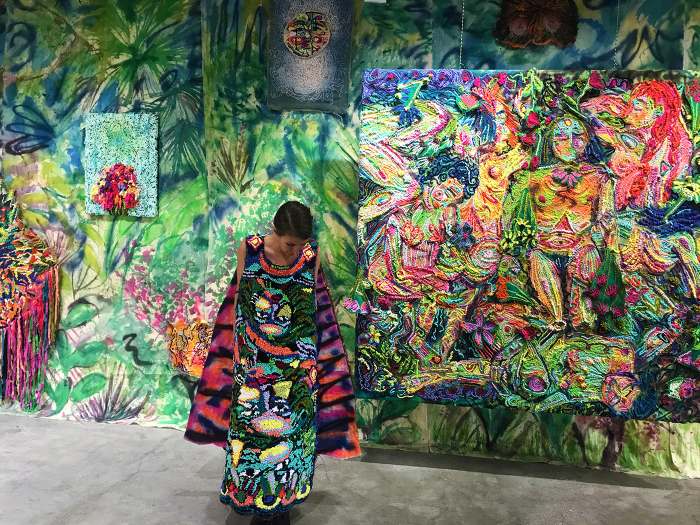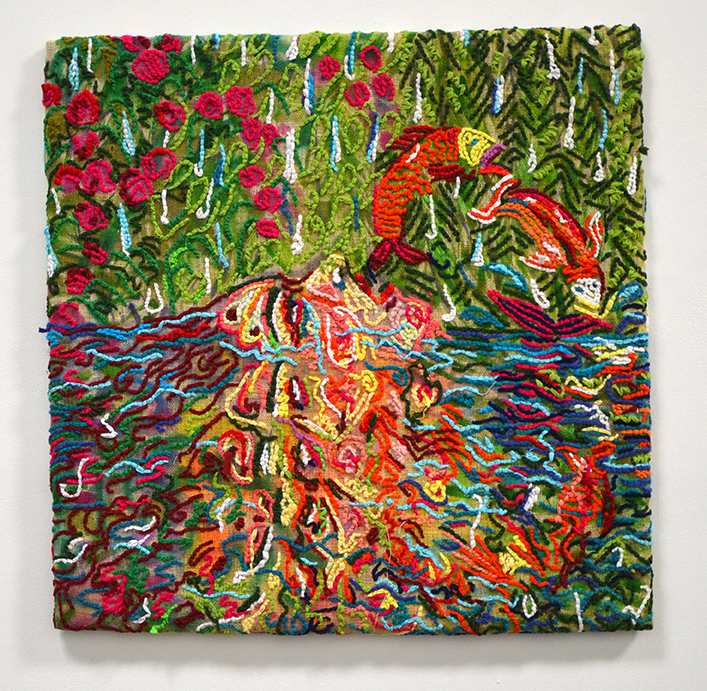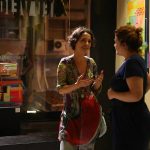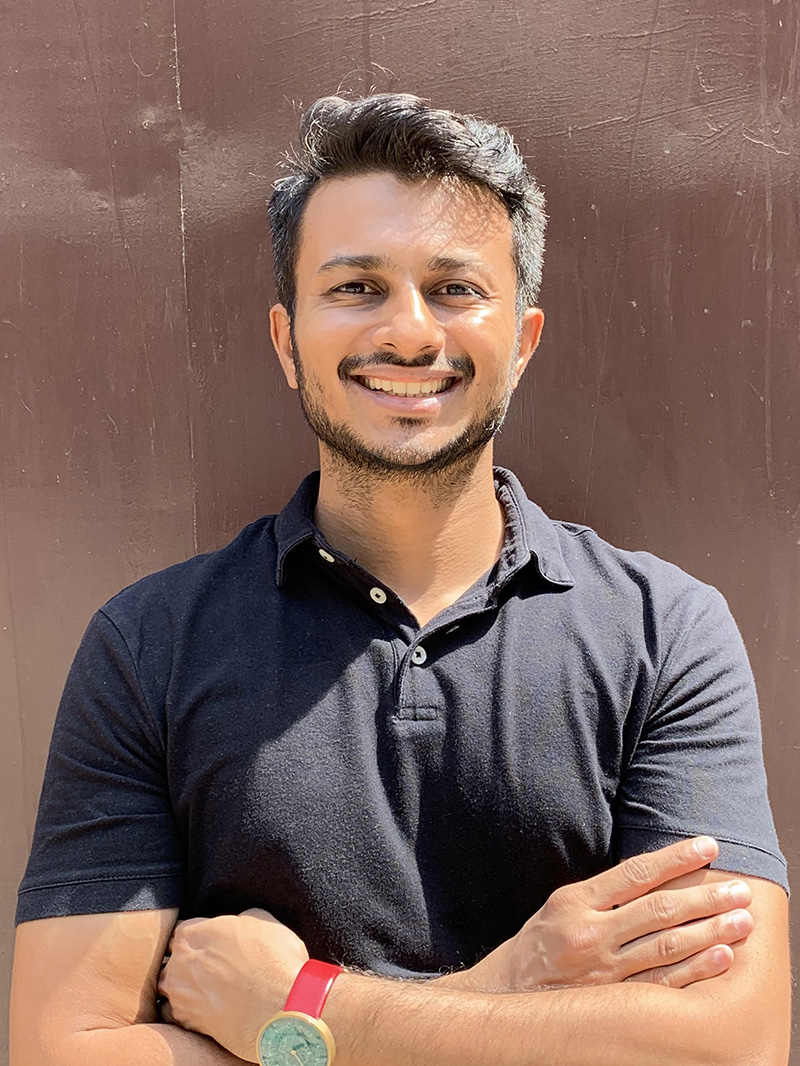Los Angeles based textile artist Liv Aanrud talks about honing in on her medium after she discovered a run made by her grandmother. And there was no turning back. An interview for the Asian Curator.

Artist interview
Please tell us a little about yourself.
I’m a textile artist living in Los Angeles. Ispend as much time as I can working in my studio in my home near Elysian Park, and normally work as a bartender. I’ve been here for in LA for 8 years. It’s actually the longest I’ve hung my hat in one place for a while. LA has a great community of artists and art spaces that are definitely unique to any place I’ve lived; it’s obviously an immensely creative town, and you can still feel that energy. Even in these strange times people continue to make things happen.
I grew up in rural Wisconsin on a small family farm. It’s a way of life that’s nearly gone and seems like it’s either romanticised or mocked. However, I feel really fortunate to have this particular childhood—so much of my relationship to the world and my art practice stems from living surrounded by nature in a small, tight knit community. There were a range of ideas on how to live, but ultimately was one where one was expected to work hard, solve problems, and help your neighbours. Being a farmer requires a particular balance of humour, humility, tenacity and the ability to survive without much money or any health insurance for long stretches of time…so too is the life of an artist. Thanks Dad!!!
Let’s talk about the evolution of your practice and medium of art over the years. Tell us about your commitment to your current medium in art.
For the last decade nearly, my artwork is constructed though a combination rug hooking and painting. I was primarily an abstract painter for years, and I had no background in textiles, but I taught myself a method of weaving after I found a rag rug that my grandmother had made. We’d been very close when I was young, and she definitely nurtured my interest in art, so it was so exciting to come across this tapestry years after she’d died. I had so many questions about this strange abstract piece and the serendipity of finding it when I did.
It seemed to me a kind of self-portrait made of the bits of her life: old dish rags that held tight to their usefulness, a snip of dress to pretty to throw away, the scribbled lines that seemed to be the map of an afternoon daydream and the potato sack that held the whole arrangement together. All this rolled up to kept the draft out from under the door—such poetic sufficiently!
Ten years later, I’m still interested in this process as I make “fabric paintings.” I refer to them this way as I tend to work with a painter’s mind, and weaving is another means of mark making– a way to make a painting that feels more physical. I begin with a quick sketch on burlap, then take scraps of fabric I’ve cut and hook them through. I’ve come to crave this stitch- the tick-tock rhythm that gives my mind a chance to wander. I recently got a tufting gun and hand tool, and while the mark has simultaneously grown quicker and smaller, I still find the same solace in this new beat.

What themes you are currently working on?
Lately, my work is focused on the figure, but within the multitude of stitches that make up a piece there are plenty of moments of abstraction, (hello old friend!) and I definitely revel in that too. I reference my own body and other imagery. Let’s call it “observational weaving” as I make a kind of emotional self-portrait. Ultimately, I don’t intend the figures to look like me. But there’s always a part, bend of an arm, tilt of head, curve of a belly, that IS me, and sometimes that small piece of a pose can generate the rest of the painting.
More recently, I’ve been experimenting with making wearable pieces and incorporating performance into my work. The last solo show I had in Los Angeles featured a 40 foot burlap backdrop painting over which I hung and stacked woven pieces. A friend who is a dancer then did a performance while wearing a tapestry. At one point she swung the works that hung from the ceiling in this kind of wonky pendulum. In that moment, the entire show was activated and became one living piece. I definitely want to see that again, but until it’s safe to do that kind of live performance, I am also putting together some video work that focuses on wearable pieces in different situations.
How does your audience interact and react to the work you put out into the world?
The first thing I always notice about people who view my work is that there is this innate desire for touch. The materials are common–we all know what cotton, burlap or yarn feels like and perhaps it’s that familiarity that makes them seem so accessible. I invite this tactile understanding, but I also hope that the viewer is not entirely sure what’s going on visually. There is a lot of information in each piece: thousands of stitches, vibrating colors, and meandering lines. My mind tends to focus on small sections, then I get a flash of the whole, but I can never truly see the entire thing. I hope the viewer also has this slightly disorienting experience.

What does the creative process mean to you?
It really is a gift to be able to spend time in a studio and just work. I didn’t always feel justified or comfortable claiming my space as an artist and trusting this time, whatever the outcome. There is freedom in this act of exploration that is not always built into the capitalist model of living…the big fear is a day where you “didn’t get anything done.” The process of making artwork is therapeutic, it helps me organize my thoughts and maintain balance in my life, and that is enough to keep me in my studio!
How do you deal with the conceptual difficulty and uncertainty of creating new work?
I think as artists we know that you have to take risks and make mistakes in order to really get into the good work. In theory YES! But in practice… oh the misery!! Ha ha…I am very impulsive when starting a piece and then, as if snapping out of a daze, I suddenly I’m super hard on myself and have no confidence in what I’m doing. There’s always a point where I think I’ve been betrayed by my own idea (How dare I! and then later come into this weird place of understanding, however reluctantly. I realize that each piece is actually a portrait in that sense too—spontaneity followed by scrutiny, playfulness and pensiveness in equal measure.

Tell us about your art studio, what kind of place is it?
I work in a small bedroom studio and store most of my older work in a crawlspace in the ceiling, like a squirrel in human form. On a given day I’ve woven myself into a corner and there’s probably 5 sq feet of free floor space, surrounded by a tangle of yarn, stacks of fabric, tools, cords and stretcher bars. I hang my artwork as well as some of my friend’s art, postcards, photos, and random keepsakes on the walls and ceiling and any remaining shelves or windowsills are filled with plants, paint jars, pencils and half empty water glasses. It’s a comfortable kind of chaos.
Any mentor, curator or gallerist who deserves a special mention for furthering your career as an artist?
My former professor Steve Katrosits is always someone close to my heart. I have his photo on my studio wall—a smiling face between a bald head and a beard that I miss so much. He taught me about art, how stay young at heart, and the importance of a good beer…
Artist contact
For enquiries contact: livaanrud@gmail.com
Before you go – you might like to browse our Artist Interviews. Interviews of artists and outliers on how to be an artist. Contemporary artists on the source of their creative inspiration.












Add Comment